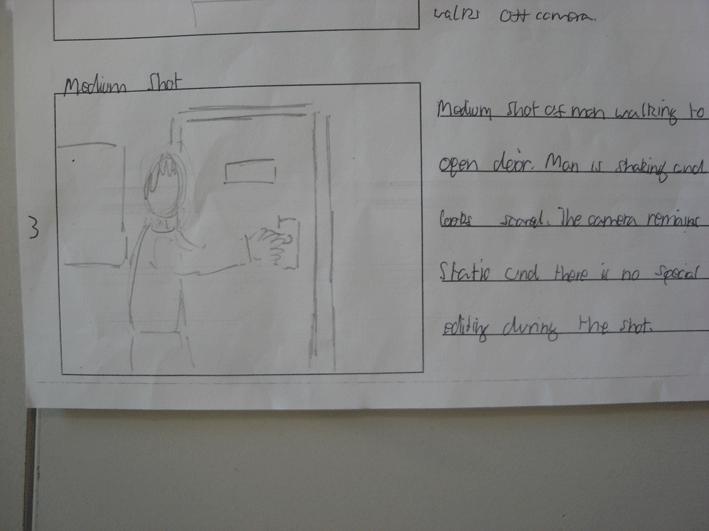The sequence begins in Morgan Freeman's character's house. Because of the low key lighting used, it suggests that it is early morning and he is undergoing his morning routine. We understand that he is an organised and civilised person by the way he moves and acts, another sign of this would be how his clothes and possesions are layed out in a neat, orderly manner.
In the next shot, the interior of a different house is shown where an investigation of a murder seems to be taking place. This is where enigma codes begin to crop up. for example - why was the man murdered? how was he murdered? why did morgan's character care whether the kids saw the crime? and which city are they in? the answers to these questions aren't revealed in these first few sequences so that the audience begin to feel involved as they try to work out the answers for themselves.
We then meet Brad Pitt's character. He is quite the opposite to Morgan Freeman's character. He is clearly unexperienced and naive. These signs are given off due to various different things:
- Chewing gum, gives a sense of youth
- The way he walks
- The way he talks - short answers, spoken in an arrogant manner
- He bumps into someone in the street, showing that he is a person with little respect.
Another enigma code is brought onto the scene when we meet this character - why did he move to this city? Despite the fact that we are unaware of the location of the film, the setting really sets the mood, due to rain and a grey, misty atmosphere.
The use of enigma codes in this opening sequence are very effective, as it makes the viewer want to continue watching to find the answers. I believe - as a group - we need to involve something like this in our thriller to hold interest and to keep the audience guessing.
The whole aim of this opening is to introduce us to the Protagonists, and to give us an idea of what they're like as people. This is very different to the other thrillers i have commented on as the identities of the characters tend to remain hidden throughout the first few sequences.
Restricted narrative is used, in the sense that we don't know how or why the character was murdered. This creates a bond between the audience and the Protagonists as they learn about the murder together later on in the film, this builds suspense and holds interest in the audience.
Seven Opening Analysis - Chris Forrest
The sequence begins in Morgan Freeman's character's house. Because of the low key lighting used, it suggests that it is early morning and he is undergoing his morning routine. We understand that he is an organised and civilised person by the way he moves and acts, another sign of this would be how his clothes and possesions are layed out in a neat, orderly manner.
In the next shot, the interior of a different house is shown where an investigation of a murder seems to be taking place. This is where enigma codes begin to crop up. for example - why was the man murdered? how was he murdered? why did morgan's character care whether the kids saw the crime? and which city are they in? the answers to these questions aren't revealed in these first few sequences so that the audience begin to feel involved as they try to work out the answers for themselves.
We then meet Brad Pitt's character. He is quite the opposite to Morgan Freeman's character. He is clearly unexperienced and naive. These signs are given off due to various different things:
- Chewing gum, gives a sense of youth
- The way he walks
- The way he talks - short answers, spoken in an arrogant manner
- He bumps into someone in the street, showing that he is a person with little respect.
Another enigma code is brought onto the scene when we meet this character - why did he move to this city? Despite the fact that we are unaware of the location of the film, the setting really sets the mood, due to rain and a grey, misty atmosphere.
The use of enigma codes in this opening sequence are very effective, as it makes the viewer want to continue watching to find the answers. I believe - as a group - we need to involve something like this in our thriller to hold interest and to keep the audience guessing.
The whole aim of this opening is to introduce us to the Protagonists, and to give us an idea of what they're like as people. This is very different to the other thrillers i have commented on as the identities of the characters tend to remain hidden throughout the first few sequences.
Restricted narrative is used, in the sense that we don't know how or why the character was murdered. This creates a bond between the audience and the Protagonists as they learn about the murder together later on in the film, this builds suspense and holds interest in the audience.































No comments:
Post a Comment